![]()
![]()
![]()
Use LEFT and RIGHT arrow keys to navigate between flashcards;
Use UP and DOWN arrow keys to flip the card;
H to show hint;
A reads text to speech;
16 Cards in this Set
- Front
- Back
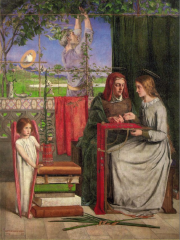
|
"THE GIRLHOOD OF THE VIRGIN MARY," DANTE GABRIEL ROSETTI (1848-490; OIL ON CANVAS. TATE GALLERY. LONDON, ENGLAND.
St. Anne talking to her daughter, virgin mary, and the lilies symbolize innocence. Shows a religious scene, muted color palette, one point linear perspective, and a scene of morality. |
|

|
"FONDACO DEI TURCHI, VENICE," JOHN RUSKIN (1849-51). RUSKIN MUSEUM. CONISTON, ENGLAND.
A watercolor painting, and the artist saw the academy as a factory that produced artists. He turned to Gothic art because he felt it was "free." |
|
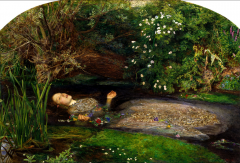
|
"OPHELIA," JOHN EVERETT MILLAIS (1852); OIL ON CANVAS. TATE, GALLERY. LONDON, ENGLAND.
Painting shows sensitivity and love of nature. Millais was the founder of the pre raphaelites movement. Depicts Ophelia's death from Hamlet. |
|

|
"BEATA BEATRIX," DANTE GABRIEL ROSETTI (1863); OIL ON CANVAS. THE GALLERY. LONDON, ENGLAND.
An image of Rosetti's late wife in the form of Beatrice from Dante's inferno (The comedy). A symbol of her velopium overdose. |
|
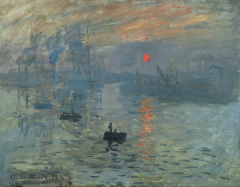
|
"IMPRESSION: SUNRISE," CLAUDE MONET (1872); OIL ON CANVAS. MUSEE MARMOTTAN. PARIS, FRANCE.
This painting is emblematic of the impressionism, and was one of the first exhibited impressionist paintings. A depiction of the Blahogna River.
|
|
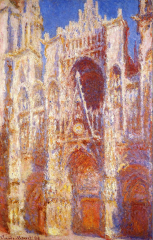
|
"ROMAN CATHEDRAL: THE PORTAL (IN SUN)," CLAUDE MONET (1894); OIL ON CANVAS. METROPOLOTAIN MUSEUM OF ART. NEW YORK CITY.
Shows how light itself conveys form through its refractory. |
|

|
"SAINT-LAZARE TRAIN STATION," CLAUDE MONET (1877); OIL ON CANVAS. MUSEE D'ORSAY. PARIS, FRANCE.
A focus on the light and momentary feeling of the train. Usually focused on scenes of everyday life. Shows the effect of new technology on the world. |
|
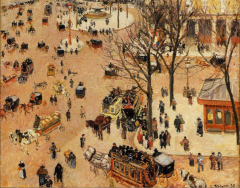
|
"LA PLACE DU THEATRE FRANCAIS," CAMILLE PISSARO (1898); OIL ON CANVAS. LOS ANGELES COUNTY MUSEUM OF ART. LOS ANGELES.
Has blurred and heavy brushstrokes and was also influenced by photography. Has a sense of a momentary encounter. |
|
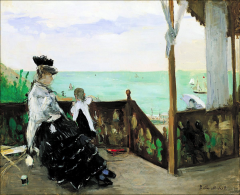
|
"VILLA AT THE SEASIDE," BERTHE MORISOT (1874); OIL ON CANVAS. NORTON SIMON ART FOUNDATION. LOS ANGELES.
Usually painted scenes of domestic life, and clearly has the influence of Eduard Manet. Usually painted scenes with mother and child. |
|
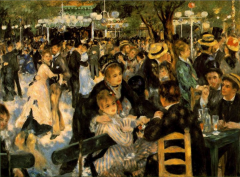
|
"LE MOULIN DE LA GALETTE," PIERRE AUGUSTE RENOIR (1876); OIL ON CNVAS. MUSEE D'ORSAY. PARIS, FRANCE.
Shows interest in light, and has an evocation of life through color, and new leisure. |
|
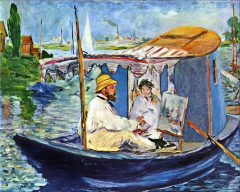
|
"CLAUDE ONET IN HIS STUDIO BOAT," EDOUARD MANET (1874); OIL ON CANVAS. NEU PINAKOTHEK. MUNICH, GERMANY.
This painter also painted "Olympia," and shows brevity in nature aside from the industrialization. |
|

|
"A BAR AT THE FOLIES-BERGERE," EDOUARD MANET (1882); OIL ON CANVAS. COURTAULD INSTITUTE OF ART GALLERY. LONDON, ENGLAND.
Has a carefully recorded diagonal reflection of the bar maid. Depicts her blank stare at customers. Manet attempts to play with perspective. |
|

|
"THE REHEARSAL," EDGAR DEGAS (1874); OIL ON CANVAS. GALLERIES AND MUSEUM. GLASGOW, SCOTLAND.
Reflects impressionists leanings and also has a photographic like perspective. Degas had in interest in ballerina's and women. |
|
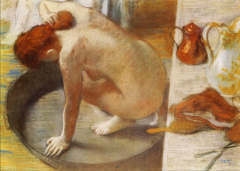
|
"THE TUB," EDGAR DEGAS (1886); PASTEL. MUSEE D'ORSAY. PARIS, FRANCE.
Influenced by the eroticism of Japanese paintings. Inspired by Kiyogna and has symmetry, an odd viewpoint and a shimmery golden look. |
|

|
"THE BATH," MARY CASSATT (1892); OIL ON CANVAS. ART INSTITUTE OF CHICAGO. CHICAGO.
She was an American artist that moved to Paris, and traveled before settling. Degas became a life-long friend/ mentor. |
|

|
"NOCTURNE IN BLACK AND GOLD (THE FALLING ROCKET)," JAMES MCNEIL WHISTLER (1875); OIL ON PANEL. DETROIT INSTITUTE OF THE ARTS. DETRIOT.
Has a strong sense of impressionism, he was interested in sensations of light and the color change created. This painting resembled symphonies (A musical piece that resembled night.) |

